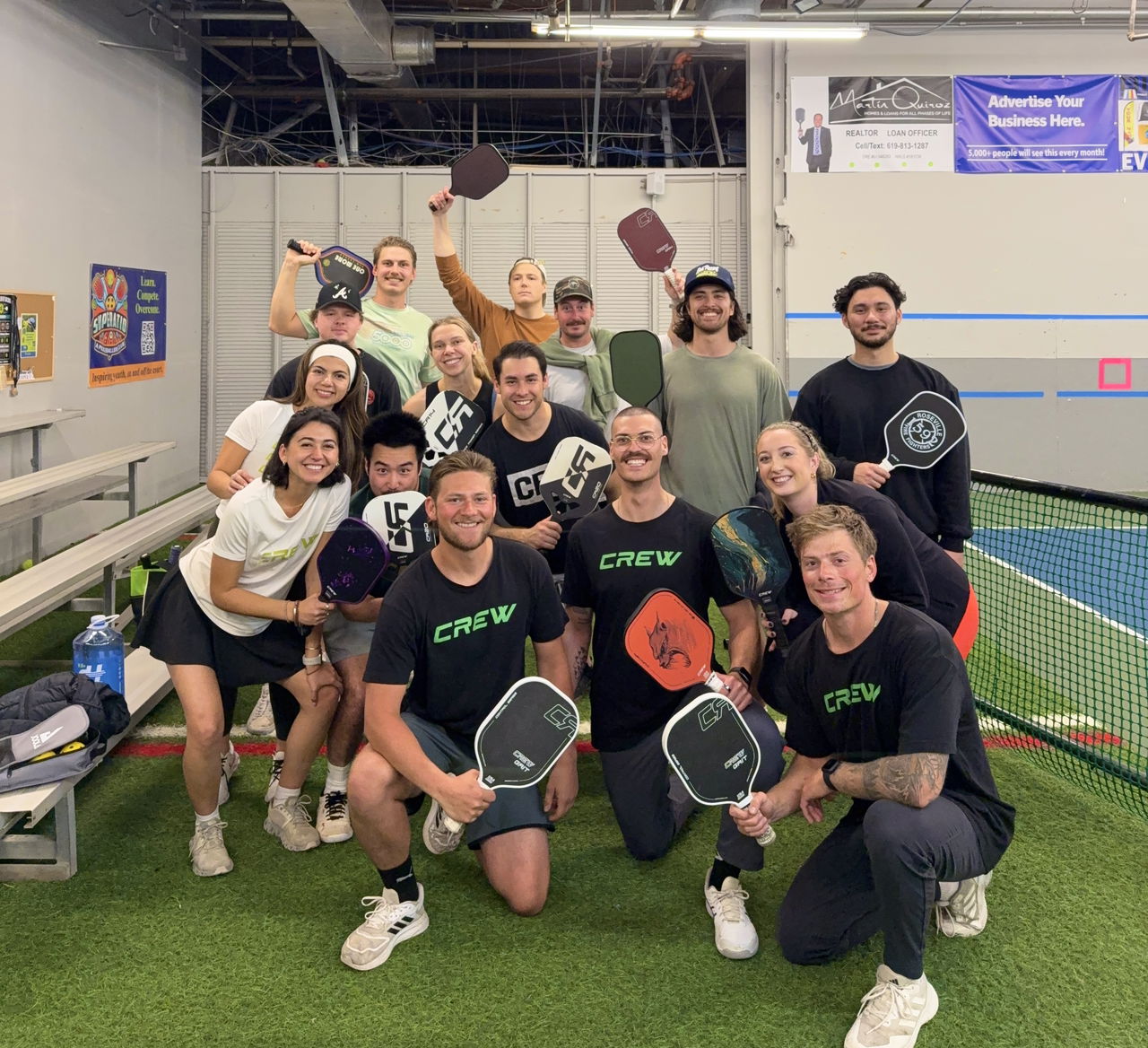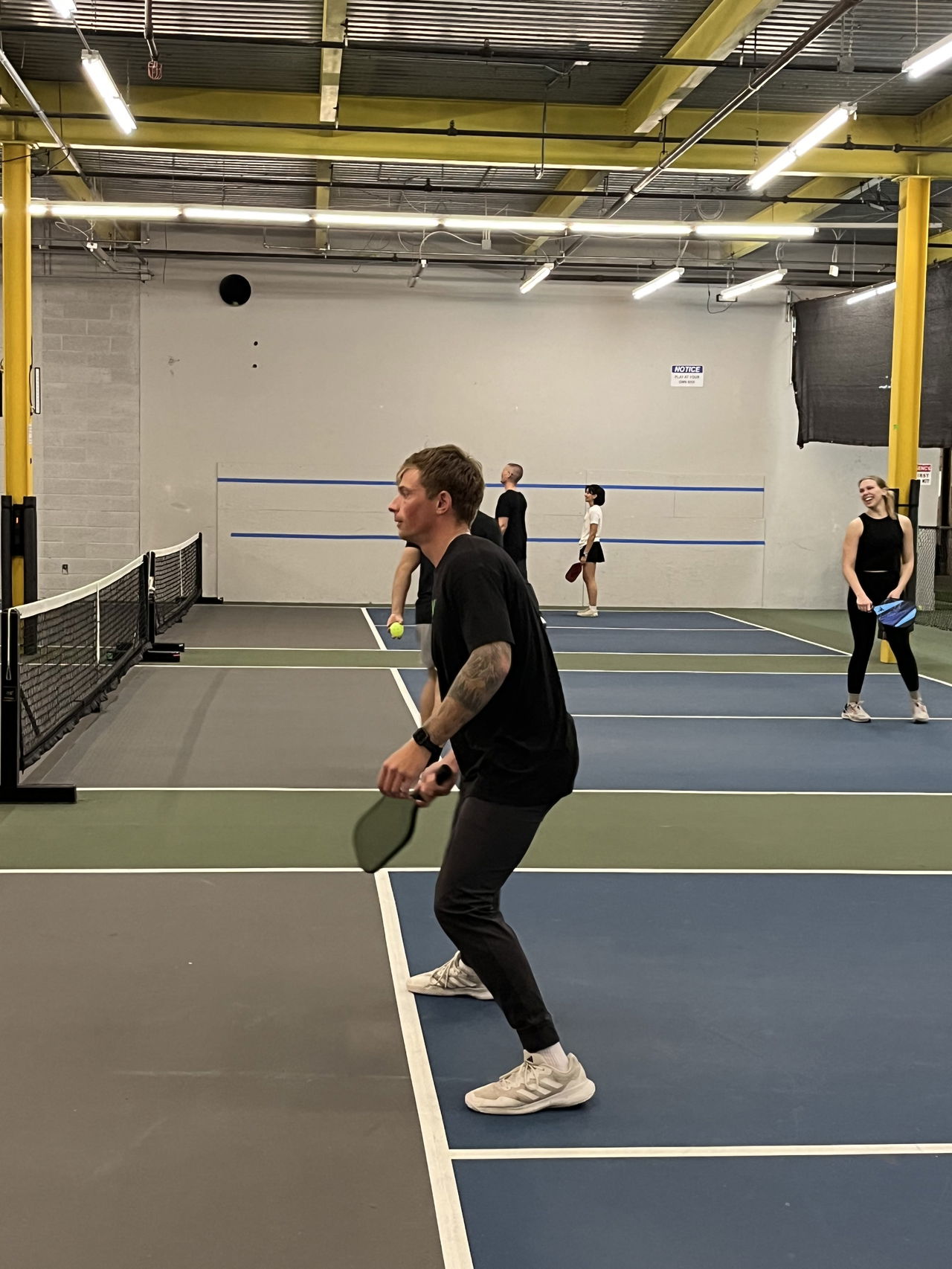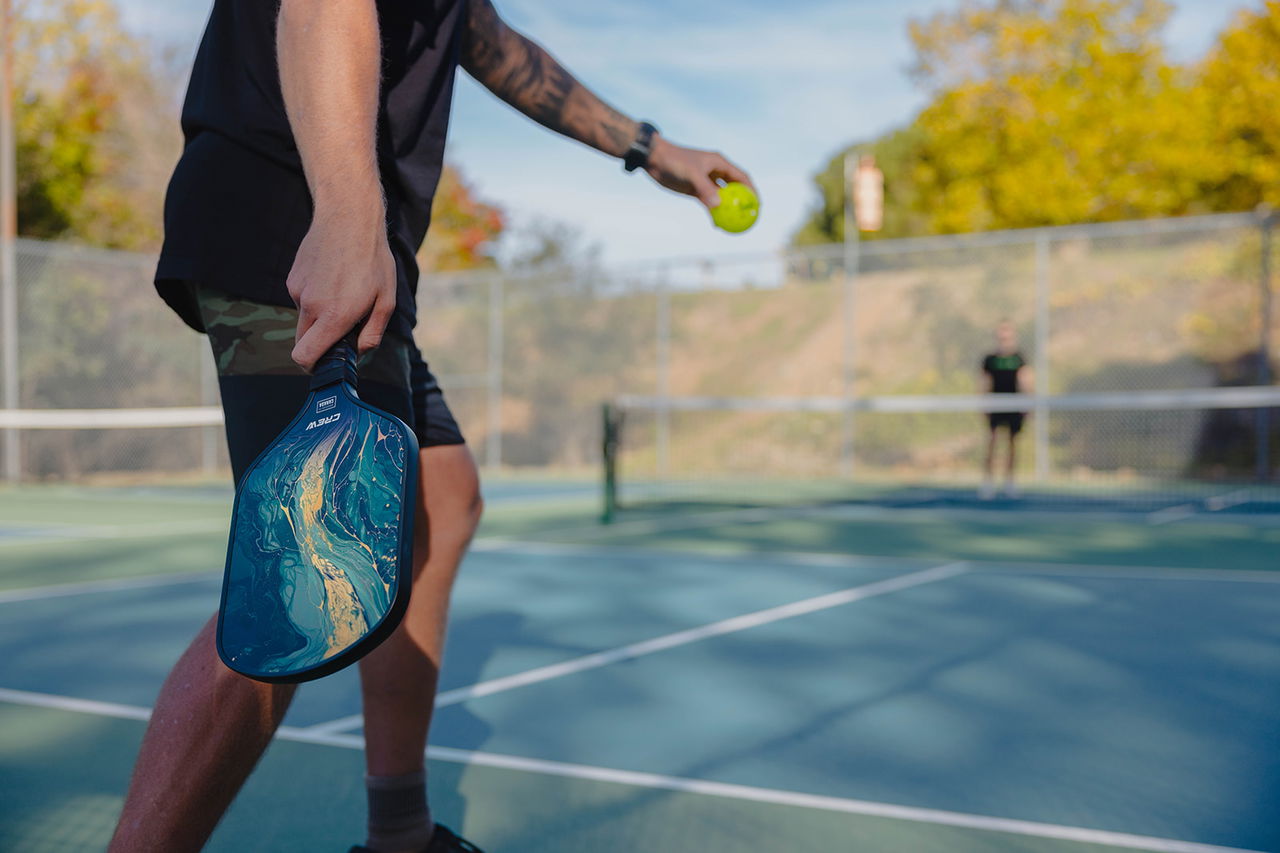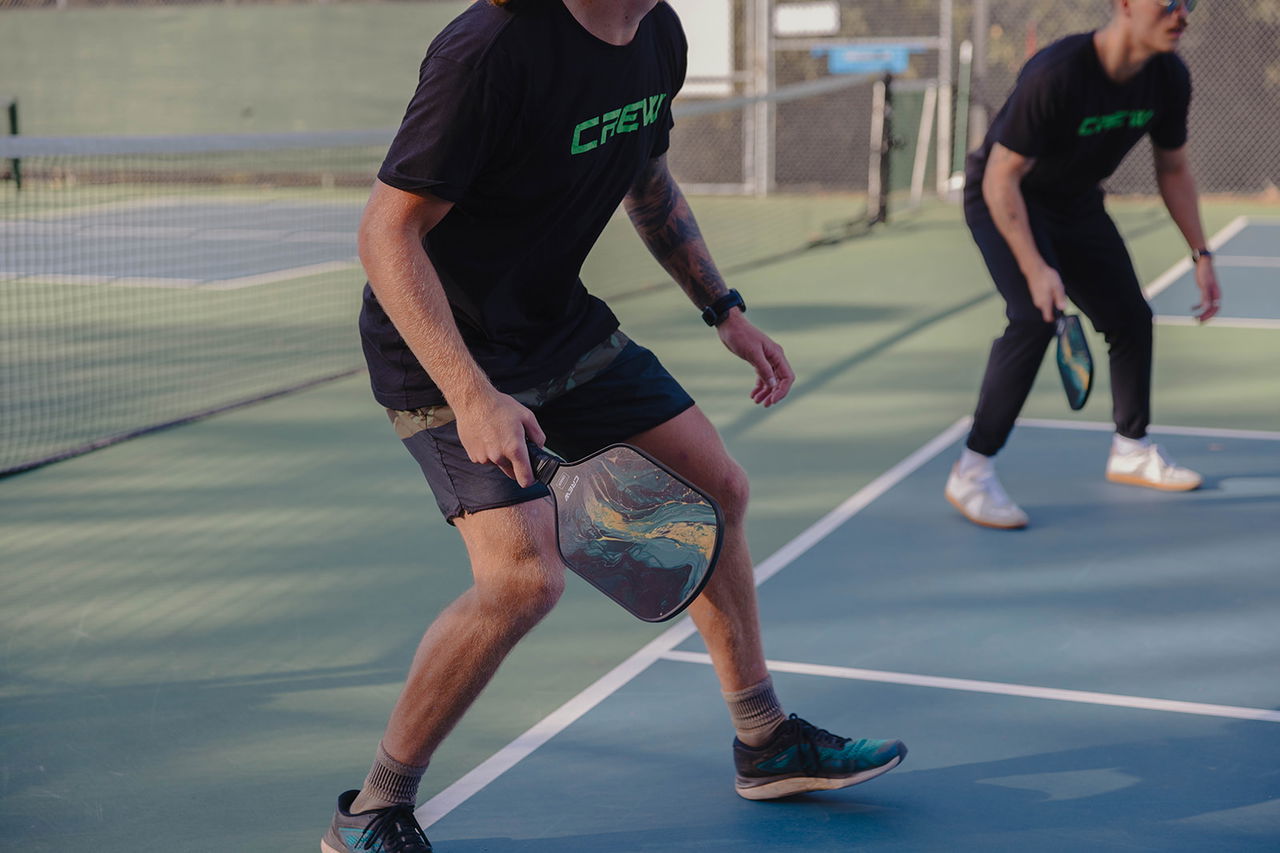Pickleball Guide
How to Play Pickleball: All You Need To Know
Pickleball is the perfect mix of fun, fitness, and friendly competition. Whether you’re new to the game or need a refresher, this guide will walk you through everything you need to know to start playing pickleball like a pro—or at least look like one.
6 min. read

Written by
Carter Clark
Published
Jan 4 2025
Key Takeaways
Pickleball is easy to learn with simple
pickleball instructions
and requires minimal equipment—just a paddle, ball, and court shoes.
Games are played to 11 points, and the two-bounce and kitchen rules keep it fair and engaging.
Whether played as singles or doubles, pickleball is an energetic, social sport that welcomes
players of all skill levels.
How to Play Pickleball

Pickleball is played on a court the size of a badminton court (20' x 44') with a net that stands 36 inches high at the sidelines and dips to 34 inches at the center. Each side features a 7-foot area known as the non-volley zone—or "kitchen"—where players cannot hit the ball directly out of the air (a volley).
The game is typically played in a doubles format, with two players per team. This guide focuses primarily on doubles rules. If you’re interested in singles play, check out our dedicated guide for that variation.
Here’s a quick overview of the 7 main rules of pickleball. Keep reading for a detailed breakdown of each one!
Rule #1: Every rally kicks off with a serve
A pickleball game—and each rally—always begins with a serve. The serve starts with the player positioned on the right-hand side of the court. They must hit the ball diagonally to their opponent, aiming for the correct service area:
The server can hit the ball directly out of the air (a "volley serve") or let it bounce first. Regardless of the method, the serve must clear the kitchen, including the kitchen line.
For a volley serve, the ball must be struck with an underhand motion, using either a forehand or backhand stroke.
Contact with the ball must be made below the waist, and the paddle should follow an upward arc as it strikes.
Rule #2: The ball must bounce once on each side before either team is allowed to hit a volley.
Before a player can hit the ball out of the air (a volley), it must bounce once on each side. It is called the "two-bounce rule."
If your partner is serving and you position yourself in the kitchen, you’re putting yourself in a risky spot. Why? Because the returning team can aim their shot directly at you. If you volley the ball without letting it bounce on your side first, it’s a fault, and you’ll lose the point.
This rule is crucial because the serving team could quickly rush the net and dominate without it, creating an unfair advantage.
Rule #3: Each point continues until a fault occurs
After the serve, play continues until the rally ends with either a winning shot or a "fault." A fault signals the end of the rally. In pickleball, there are four main types of faults:
The serve lands outside the designated service area or in the kitchen (including the kitchen line).
The ball lands out of bounds, such as beyond the baseline or outside the sidelines.
The ball hits the net and fails to cross to the opponent's side.
The ball bounces twice on one side before being returned.
Rule #4: Volleys are not allowed in the kitchen

The 7-foot area on each side of the net is known as the non-volley zone or "kitchen." True to its name, you're not allowed to hit a volley while any part of your body is in this zone—or even touching the kitchen line.
Your momentum cannot carry you into the kitchen after a volley. However, you can hit the ball in the kitchen if it bounces first.
For example, if your opponent plays a short shot that lands in the kitchen, you're free to step in and return it—as long as it’s not a volley.
Rule #5: Points can only be scored on your serve
In traditional pickleball scoring, points are earned only during your team’s serve. The server keeps serving until a rally is lost.
After each point is scored, the server and their partner switch positions (left to right), and the serve is directed to the other opponent. If your team loses a rally, the serve passes to your teammate, who follows the same serving sequence.
Once your team loses another rally, the serve “sides out” and goes to the opposing team.
Rule #6: Announcing the correct score before serving
In pickleball, players announce three numbers before serving, such as "0-0-2." Here's what each number represents:
First Number: The serving team's score
Second Number: The receiving team's score
Third Number: The server's position, either the first server (1) or second server (2)
If the game is tied at 3-3 and you are the first server, you would announce "3-3-1" before serving. It signals that you're the first player in your team’s serving rotation.
If you lose the rally, the serve doesn’t immediately go to your opponents. Instead, it transfers to your teammate, who will call "3-3-2" as they take their turn to serve.
If your teammate also loses their serve, a "side out" occurs. It means your team has used both serve, and now it’s the opposing team’s turn to serve. They’ll start by announcing "3-3-1."
There is one exception to this rule: At the start of a game, the first server calls "0-0-2." It is because the serving team only gets one serve initially, balancing the advantage of serving first.
Rule #7: The first team to reach 11 points wins—but victory requires a 2-point lead.
The game continues until one team reaches 11 points, following all the standard rules. However, winning requires a 2-point margin.
If the score is tied at 10-10, the game doesn’t end with the next point. Play continues beyond 11-10 until one team pulls ahead by 2 points.
This rule can extend the game significantly, with final scores like 12-10, 15-13, or even 21-19. These intense matches often turn out to be the most exciting!
What You Need to Play Pickleball
Before diving into the game, make sure you have the essentials:
Pickleball Gear:
, balls,
and potentially a portable net if your local courts don’t have permanent ones.
Pickleball Clothing: Comfortable gear like quality pickleball shoes and fresh socks can enhance your performance on the court.
A Local Court: Find a nearby court that’s set up for pickleball.
Know the Rules: Stay updated on the latest pickleball rule changes to play confidently.
How to Set Up a Pickleball Court
Existing Courts: You're all set if the court already has lines and a net. Just show up and play!
Courts Without Nets: Bring a portable pickleball net for courts with permanent lines but no net. Assemble it and place it in the center, similar to how a tennis net is positioned. Then you’re ready to start!
Types of Shots in Pickleball
Here’s a breakdown of the different shots you can make in pickleball:
Drives
These are potent shots taken off the bounce, often from the baseline, using either a forehand or backhand swing.
Dropshot
Often executed from the back of the court, these shots aim to softly land in your opponent’s kitchen, limiting their ability to attack and enabling you to take a better position near the kitchen.
Volleys
These shots are struck out of the air before the ball bounces but must be played outside the kitchen area.
Lobs
High-arching shots are designed to push opponents back from the kitchen and create space on the court.
Overhead
Aggressive shots hit above the head with a tennis-style motion, used to counter lobs before they hit the ground.
How to Serve in Pickleball

Every pickleball rally starts with a serve. Unlike tennis, the goal of a pickleball serve is simply to get the ball into play. According to the USA Pickleball Official Rules:
In other words, a legal pickleball serve is an underhand forehand or backhand stroke that ends with an upward motion.
Although serving is typically done out of the air, the 2021 rule update from USA Pickleball introduced the "drop serve." It allows players to drop the ball and hit it after it bounces.
Where to Serve in Pickleball
In pickleball doubles, serves must be directed to the diagonally opposite service court. To be valid, the ball must completely clear the kitchen line and land within the area between the sideline and baseline.
While the ball can touch the sideline or baseline, it cannot land on the kitchen line.
Proper Positioning for Serving
When serving, you must stand behind the baseline. Your feet must not touch the baseline or sideline until after the ball is struck.
As the serving team, you should remain behind the baseline until the third shot is hit. Moving up to the kitchen too early risks breaking the two-bounce rule.
Serving Strategies
While the primary aim of the serve is to put the ball in play, it can also be a tactical advantage. Here are three effective strategies to elevate your serve:
Serve Deep:
A deep serve pushes your opponents further back, keeping them away from the kitchen line and reducing their ability to dominate the net.
Target Weaknesses:
Aim for your opponent's weaker side—forehand or backhand. It increases the likelihood of forcing errors or weaker returns.
Add Spin (Advanced):
Adjust your paddle angle during the follow-through to introduce spin. Spin serves can disrupt your opponent's timing and lead to unforced errors.
How to Play Pickleball: Simple Rules to Get You Started
Playing pickle ball is straightforward, but there are a few key rules you’ll want to know:
These simple pickleball rules make the game accessible to beginners while still offering depth for advanced players.
What is the Two-Bounce Rule in Pickleball?

The "two-bounce rule" requires the ball to bounce once on each side of the court after a serve before any player can volley it out of the air.
Here’s how it works, using doubles as an example:
The first bounce occurs when the server hits the ball and lands in the opponent’s court.
When the opponent returns the ball, the serving team must wait for it to bounce again before hitting it.
Only after these two bounces can players legally volley the ball. If a player is near the net before the rule is fulfilled, they cannot hit the ball out of the air.
For this reason, the serving team should avoid starting in the kitchen. However, players on the receiving team (except the receiver) may position themselves near the kitchen since the ball bounced twice before reaching them.
Once the two-bounce rule is met, players can approach the kitchen and start volleying. This position is often the most strategic spot in pickleball.
How to Play Pickleball Doubles
Player Positioning
Serving Team:
One player serves from the right service box; the partner stays behind the baseline.
Receiving Team: One player stands in the diagonal service box; the partner stays at the baseline, ready to return.
After the Serve:
Both teams aim to move up to the kitchen line (non-volley zone) for better control.
Stacking Strategy:
Players can switch positions after the serve to favor stronger shots or formations.
Key Rules
Serve Must Be Underhand: Paddle must stay below waist level, and the serve must go diagonally.
Double Bounce Rule: The ball must bounce once on each side before volleys are allowed.
Kitchen (Non-Volley Zone) Rule:
Players cannot volley (hit in the air) while standing inside the 7-foot non-volley zone.
Scoring:
Only the serving team can score; games are typically played to 11 (win by 2).
Switching Serves:
The first server continues until a fault; then, their partner serves before turning over to the opposing team.
By mastering positioning and these simple rules, you’ll be dominating the pickleball court in no time! 🚀🎾
How to Play Pickleball Doubles
Master Your Serve
Start each point strong with a consistent, well-placed serve. Aim deep in the service court to keep your opponent on their toes. Practice regularly to make it second nature.
Focus on Placement, Not Power
Precision beats brute force in pickleball. Aim for open spaces or your opponent’s weaker side rather than trying to hit the ball as hard as possible.
Communicate with Your Partner
In doubles, clear communication is key. Call out shots, decide who covers which area, and encourage each other to stay in sync.
Keep an Eye on the Kitchen
Avoid stepping into the non-volley zone (kitchen) unless the ball bounces first. Many points are lost from careless footwork around this area.
Stay Light on Your Feet
Taking small steps will help you adjust to the ball’s movement and maintain control during rallies. Being flat-footed can lead to missed opportunities.
Practice Patience
Don't rush to hit the ball at every opportunity. Wait for the right moment to attack, especially when your opponent makes a mistake or leaves an opening.
Keep It Fun
Pickleball is all about enjoying the game. Laugh off mistakes, remain positive, and relish the camaraderie on the court.
Final Thoughts
What are you waiting for? Pickleball is calling! Grab any paddle, find a court near you, and join a fun and rewarding game.
Whether you’re there to compete, laugh, or move your body, pickleball offers an experience unlike any other. Try it once, and you might find yourself hooked. Game on!
Ready to master pickleball? Crew Pickleball has you covered with customized paddles
and top-quality gear. Start your journey today—Contact us for expert advice!

Carter Clark
@Carter Clark
